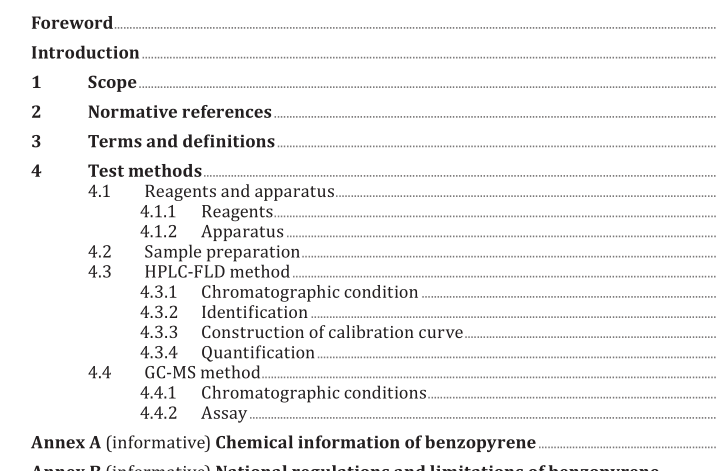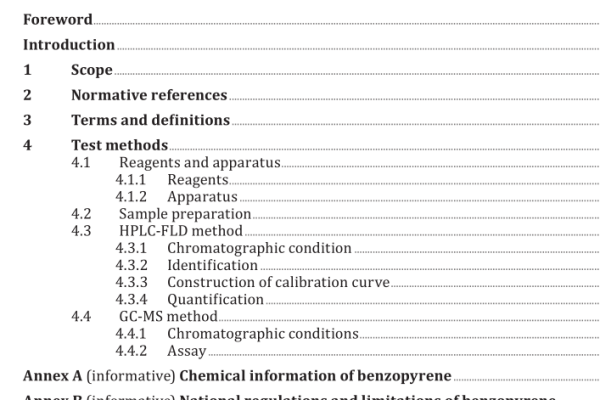ISO 23956:2022 pdf download – Traditional Chinese medicine — Determination of benzopyrene in processed natural products.
b) Add 100 ml of hexane with 1 ml of internal standard (50 μg/kg or 50 μg/l: purity ≥ 96 % for analysis grade) to a mixture by homogenization for 5 min, and extract the samples mixtures in an ultrasonic bath for 30 min. c) Transfer all mixtures into a separating funnel and collect the supernatants. d) Extract the residue twice with 50 ml of hexane as detailed in step b). e) Add water (50 ml; ≥ 18,2 MΩ) to the combined hexane fraction for washing and filter the hexane fraction using anhydrous sodium sulfate. Next, concentrate the hexane fraction at 45 °C using a rotary vacuum evaporator to approximately 2 ml. f) Wash a Florisil SPE cartridge with 10 ml of dichloromethane for activation. Clean the cartridge using 20 ml of hexane to remove dichloromethane. g) Transfer directly 2 ml of the extracts into the activated Florisil SPE cartridge and elute the extracts with 20 ml of hexane and dichloromethane mixture (volume ratio of 3:1). h) Concentrate the eluent using a visible nitrogen sample concentrator at 35 °C. Dissolve the residue in 1 ml of acetonitrile and filter the eluent through a 0,45-μm polytetrafluoroethylene (PTFE) membrane filter. i) Inject 10 μl of the final eluent into the fluorescence detector (FLD) for BaP analysis. 4.3 HPLC-FLD method 4.3.1 Chromatographic condition — Column: supelcosil LC-PAH (4,6 × 250 mm, 5 μm) or equivalent. — Column temperature: 35 °C. — Detector: excitation at 294 nm and emission at 404 nm. — Mobile phase: acetonitrile and water mixture (volume ratio of 8:2) — Flow rate: 1 ml/min. 4.3.2? Identification The retention time of the peak should be consistent with the retention time of the standard within ± 0,2 % under identical analysis conditions. 4.3.3 Construction of calibration curve a) Dissolve standard (BaP) and internal standard (3-methylcholanthrene) in acetonitrile (1 μg/ml each). Store this stock solution at 4 °C. Replace the stock solution every six months. b) Prepare standard solutions with different concentrations of 3 ng/ml, 5 ng/ml, 10 ng/ml, 20 ng/ml and 40 ng/ml with 50 ng/ml of internal standard to determine linearity. c) Adjust the concentration of test solution in range of the calibration curve. 4.3.4? Quantification In the calibration curve, the y-axis represents the ratio of the peak area of BaP to that of the internal standard (A s /A IS ), where A s is the peak area of the standard in solution for the calibration curve and A IS is the peak area of the internal standard in solution for the calibration curve.
4.4 GC-MS method 4.4.1 Chromatographic conditions — Column: Cross-linked 5 % phenylmethylsilicone, 30 m × 0,25 mm i.d. (0,25 μm), film thickness. — Carrier gas flow: He at 1 ml/min. — Injection port temperature: 300 °C. — Transfer line temperature: 280 °C. — Oven temperature (starting step): 50 °C for 1 min. — Oven temperature (middle step): increase 10 °C /min until 180 °C. — Oven temperature (starting step): increase 5 °C /min until 310 °C. — Post run: 310 °C, 3 min.
ISO 23956:2022 pdf download – Traditional Chinese medicine — Determination of benzopyrene in processed natural products






